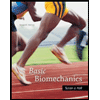
BASIC BIOMECHANICS
8th Edition
ISBN: 9781259913877
Author: Hall
Publisher: RENT MCG
expand_more
expand_more
format_list_bulleted
Concept explainers
Textbook Question
Chapter 7, Problem 8AP
8. How much tension (Fm) must be supplied by the triceps to stabilize the arm against an external force (Fe) of 200 N, given dm = 2 cm and de = 25 cm? What is the magnitude of the joint reaction force (R)? (Because the forearm is vertical, its weight does not produce torque at the elbow.) (Answer: Fm = 2500 N, R = 2700 N)
Expert Solution & Answer
Want to see the full answer?
Check out a sample textbook solution
Chapter 7 Solutions
BASIC BIOMECHANICS
Ch. 7 - Construct a chart listing all muscles crossing the...Ch. 7 - Prob. 2IPCh. 7 - Prob. 3IPCh. 7 - INTRODUCTORY PROBLEMS 4. List the muscles that...Ch. 7 - INTRODUCTORY PROBLEMS 5. List the muscles used as...Ch. 7 - INTRODUCTORY PROBLEMS 6. Explain how the use of an...Ch. 7 - INTRODUCTORY PROBLEMS 7. Select a familiar...Ch. 7 - 8. Using the diagram in Sample Problem 7.1 as a...Ch. 7 - 10. Solve Sample Problem 7.2 with the addition of...Ch. 7 - Identify the sequence of movements that occur at...
Ch. 7 - Which muscles are most likely to serve as agonists...Ch. 7 - Prob. 3APCh. 7 - ADDITIONAL PROBLEMS 4. Which muscles are most...Ch. 7 - Prob. 5APCh. 7 - Prob. 6APCh. 7 - 8. How much tension (Fm) must be supplied by the...Ch. 7 - 9. What is the length of the moment arm between...Ch. 7 - Prob. 10AP
Knowledge Booster
Learn more about
Need a deep-dive on the concept behind this application? Look no further. Learn more about this topic, bioengineering and related others by exploring similar questions and additional content below.Recommended textbooks for you

 Basic BiomechanicsBioengineeringISBN:9780073522760Author:Susan J HallPublisher:McGraw-Hill Education
Basic BiomechanicsBioengineeringISBN:9780073522760Author:Susan J HallPublisher:McGraw-Hill Education


Basic Biomechanics
Bioengineering
ISBN:9780073522760
Author:Susan J Hall
Publisher:McGraw-Hill Education
Chapter 7 - Human Movement Science; Author: Dr. Jeff Williams;https://www.youtube.com/watch?v=LlqElkn4PA4;License: Standard youtube license